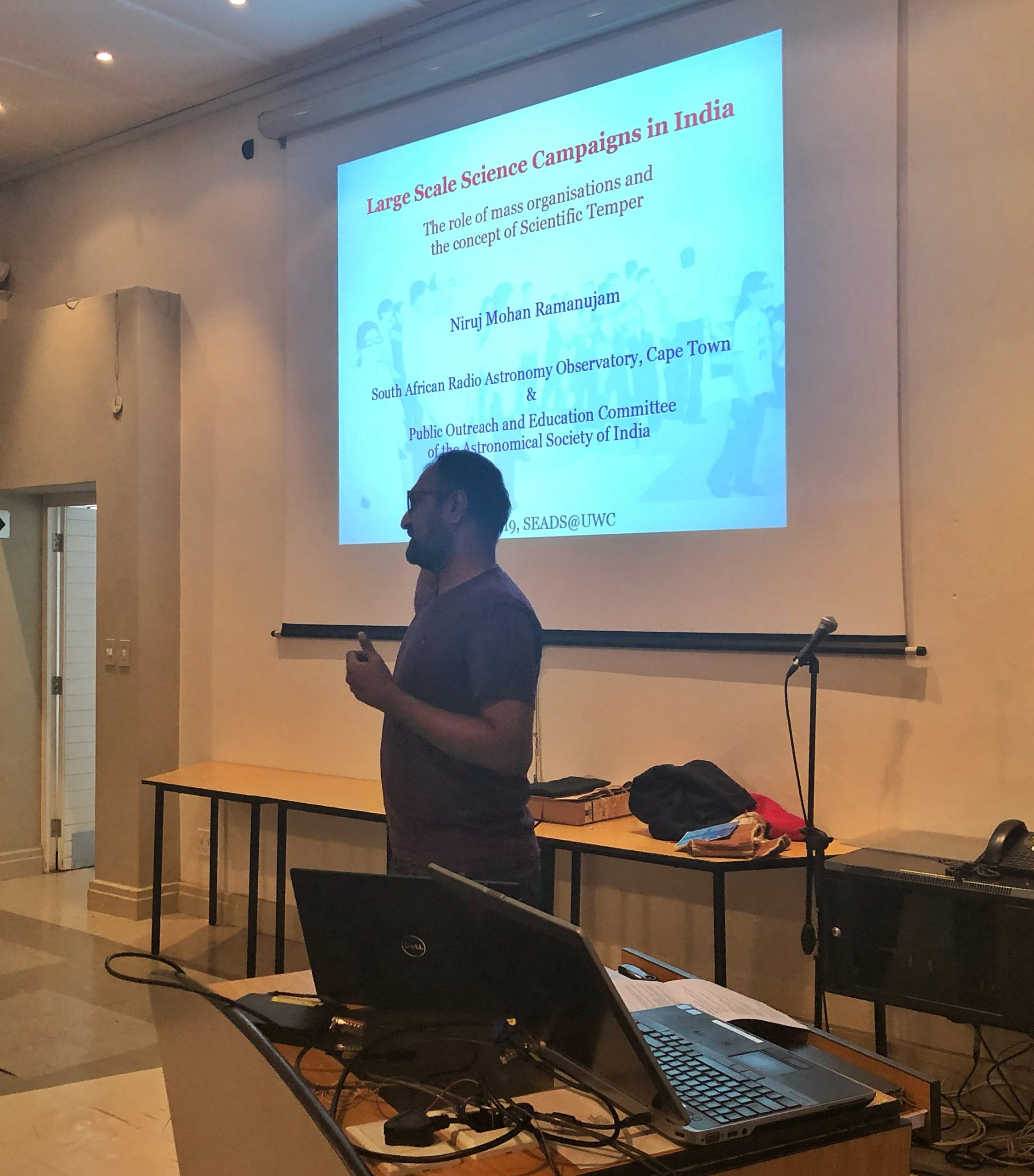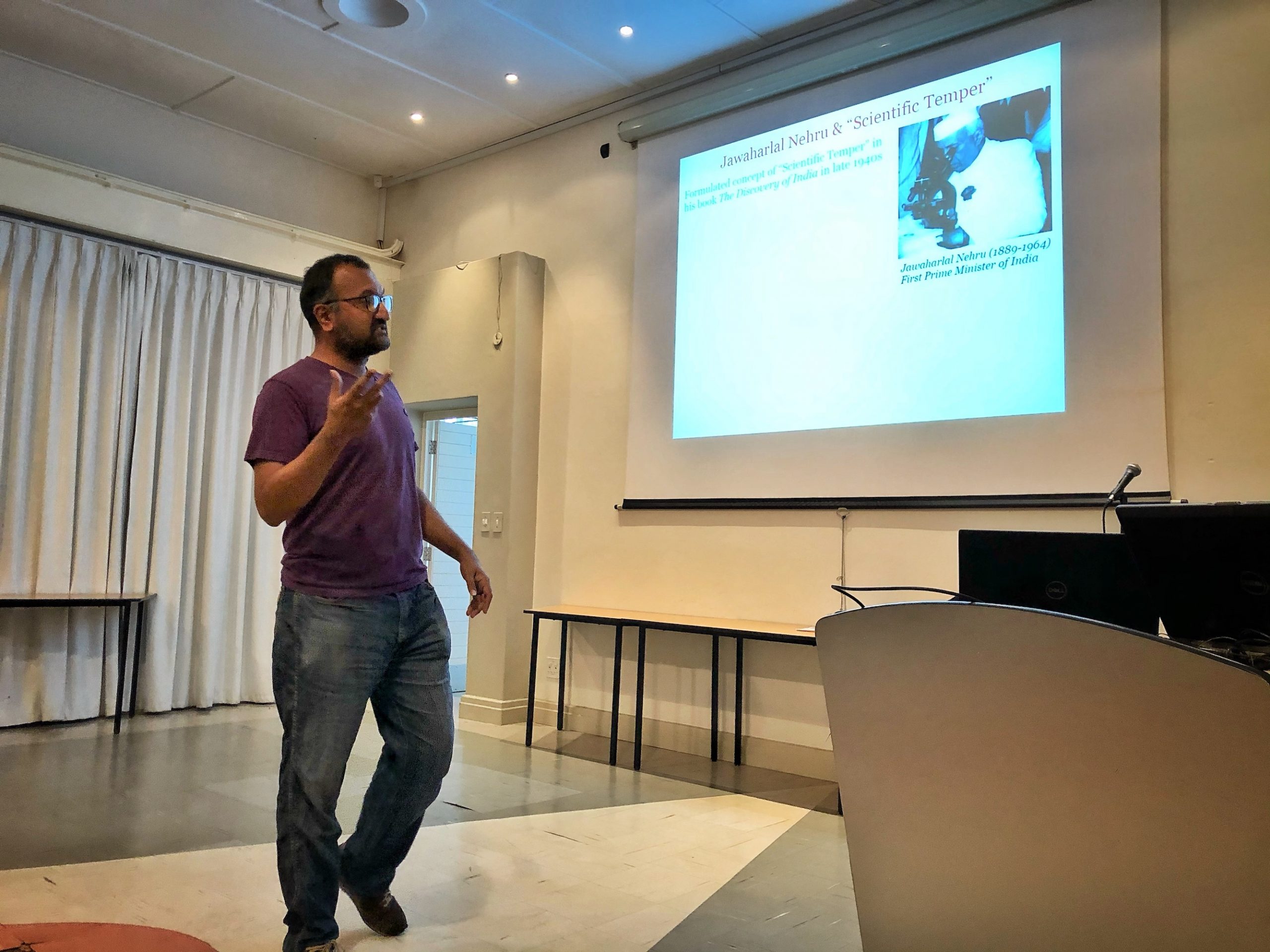This SEADS seminar was held at the South African Astronomical Observatory because access to the UWC campus was not possible. We are grateful to SAAO for hosting the seminar. It was therefore also streamed online with good participation in spite of the logistical challenges we faced.
Dr. Ramanujam covered many topics in his presentation, giving an overview of popular science movements in India, a very specific type of organisation that was motivated by the concept of “scientific temper”.
India is home to nearly 1.4 billion people and as can be expected from such a population, its history is rich in cultural diversity. India has 5 families, 22 official langs, 122 major languages, 1600 dialects and 66 scripts. This alone gave the audience a vertiginous idea of the diversity encountered in the 29 states of India.
Science and Technology have always been part of Indian culture, but the colonial history of the country damaged this tradition. Jawaharlal Nehru introduced the concept of “scientific temper” in 1946, which goes beyond the scientific method.
“[What is needed] is the scientific approach, the adventurous and yet critical temper of science, the search for truth and new knowledge, the refusal to accept anything without testing and trial, the capacity to change previous conclusions in the face of new evidence, the reliance on observed fact and not on pre-conceived theory, the hard discipline of the mind—all this is necessary, not merely for the application of science but for life itself and the solution of its many problems.” – Nehru, 1946″
This temper was equated to freedom.

This concept motivated the first Peoples Science Movement in Kerala (Kerala Shastra Sahitya Parishad – KSSP), which envisaged public ownership of science as a tool for social justice and empowerment. Science was always described in ones mother tongue. In the 19070s and 1980s, this became a mass movement and inspired People Science Movements in all other Indian states. The always promoted science in their own mother tongue.
They also introduced “Kala Jathas”, science festivals, where artists, teachers social workers, unemployed youth and science students among others celebrate science as a means to fight exploitation, discrimination, etc. They would create and perform street plays, songs, processions, public meetings and more about science, all on local languages. By now there are over 100 such festivals held annually across India with over 60,000 active members.
In 1987, a national such festival, the People’s Science Procession of India saw 26 People Science Movements join forces with government support into 5 Jathas, each covering 5000km in 30 days with 2-3 stops a day, reaching millions.
There is also the All India Peoples Science network that brings together 40 People Science Movements from across India with a membership of 300,000.
They handle topics from children’s and adult literacy, right to health, vaccinations, nutrition, rural self-reliance and rural technologies, water and sanitation, conservation and environment, and tackle sensitive subjects such as untouchability (the state of the lowest caste in Indian society), female foeticide (daughters are mot seen as positively as sons) and child marriage for example, which touch upon deeply rooted societal practices.

Astronomy campaigns for example use very little and cheap materials and while educating in scientific concepts, carry strong messages tackling, for example, superstitions, which are very prevalent in Indian societies. This is not seen as external interventions, though, as these are people’s science movements.
Another example of the work of these People Science Movements is the Toys from Trash project (see www.arvindguptatoys.com) featuring toys from discarded materials with demonstrations and videos of how these materials are used to make educational toys.
The advancement of scientific temper is not without resistance, however, and Dr. Ramanujam gave the audience examples of attacks on the scientific temper that have regrettably been on the rise in recent times. One of the issues is that questioning itself is said to be as anti-national and anti-religion by some.
One of the conclusions of the talk was therefore the need to reinvent strategies to engage the people in an anti-reason post-factual age.
The seminar was followed by lively discussions.

